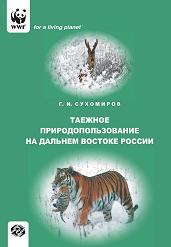Sukhomirov G.I. - Taiga Wildlife Management in the Russian Far East
 |
Sukhomirov G.I. Taiga Wildlife Management in the Russian Far East / G.I. Sukhomirov ; Rus. Acad. Sci., Far-Eastern Branch, Economic Research Institute ; WWF Russia, Amur Branch - Khabarovsk : RIOTIP, 2007. - 384 p. |
Natural and economic preconditions of the development of taiga wildlife management in the Russian Far East are considered. Definitions of game husbandry are given, the commonality of natural horticulture and hunting is substantiated. In the historical aspect, characteristics of game animal and non-wood plant resources and their development are given; data is cited on the volume of product output. Organization of game husbandry production is considered. Prospects and ways of development of complex game husbandry are considered in view of its economic, social and ecological value.
The book is intended for scientific workers, experts, and wide audience.
Key words: taiga wildlife management, game husbandry, resources of game animals, non- wood plant resources, the Russian Far East.
CONTENTS
|
Introduction ............................................................................................................... |
7 |
|
Chapter 1. GAME HUSBANDRY AND HUNTING STUDIES........................... |
13 |
|
Chapter 2. NATURAL AND ECONOMIC PRECONDITIONS FOR THE DEVELOPMENT OF COMPLEX GAME HUSBANDRY.................................. |
30 |
|
Chapter 3. THE HISTORY OF USING BIOLOGICAL NATURAL RESOURCES AND OF GAME HUSBANDRY DEVELOPMENT.................... |
45 |
|
3.1. In the long past ..................................................................................................... |
45 |
|
3.2. Before the October revolution............................................................................... |
54 |
|
3.3. During the Soviet period....................................................................................... |
73 |
|
3.4. In present time....................................................................................................... |
114 |
|
Chapter 4. GAME ANIMALS RESOURCES AND THEIR DEVELOPMENT...... |
137 |
|
4.1. Fur animals............................................................................................................ |
137 |
|
4.2. Hoofed animals..................................................................................................... |
168 |
|
4.3. Game birds............................................................................................................ |
186 |
|
Chapter 5. WILD-GROWING PLANT RESOURCES AND THEIR DEVELOPMENT.............................................................................................. |
198 |
|
5.1. Nuts....................................................................................................................... |
198 |
|
5.2. Berries and fruit.................................................................................................... |
207 |
|
5.3. Vegetable and juice-producing plants................................................................... |
225 |
|
5.4. Medicinal plants.................................................................................................... |
237 |
|
5.5. Mushrooms ........................................................................................................... |
247 |
|
Chapter 6. GAME HUSBANDRY PRODUCTION ORGANIZATION................... |
264 |
|
6.1. Intra-farm game husbandry organization ............................................................ |
264 |
|
6.2. Taking account of game animals.......................................................................... |
269 |
|
6.3. Legal system for protection and use of game animals.......................................... |
272 |
|
6.4. Game animals protection...................................................................................... |
276 |
|
6.5. The use and reproduction of game animals........................................................ |
281 |
|
6.6. Biotechnical measures in game husbandry.......................................................... |
284 |
|
Chapter 7. GAME HUSBANDRY' AND NATURAL HORTICULTURE' PRODUCTS IN THE RUSSIAN FAR EAST ......................................................... |
297 |
|
Chapter 8. DEVELOPMENT PROSPECTS OF TAIGA WILDLIFE MANAGEMENT IN THE RUSSIAN FAR EAST ................................................ |
311 |
|
Conclusion................................................................................................................... |
343 |
|
List of references........................................................................................................ |
347 |
|
Appendix 1. Basic performance of industrial farms in the Russian Far East over 1966-1990...................................................................... |
374 |
|
Appendix 2. Form to take account of game animals .................................................. |
378 |